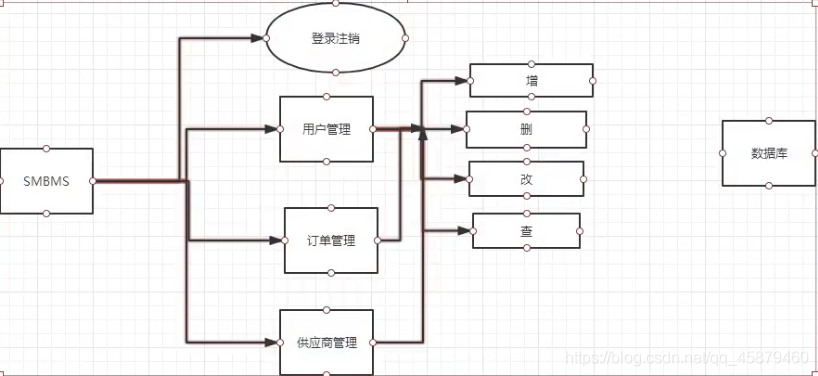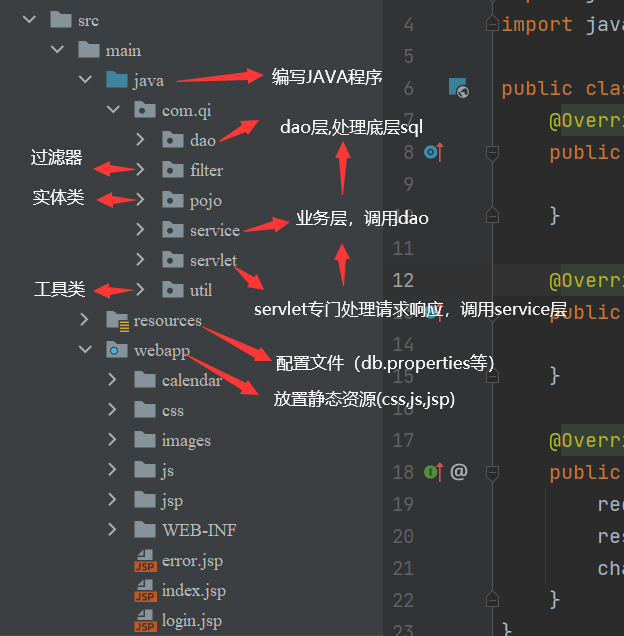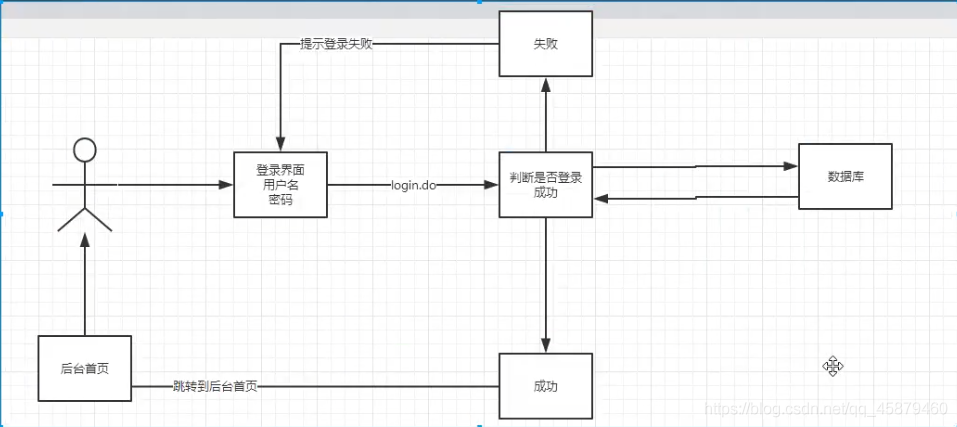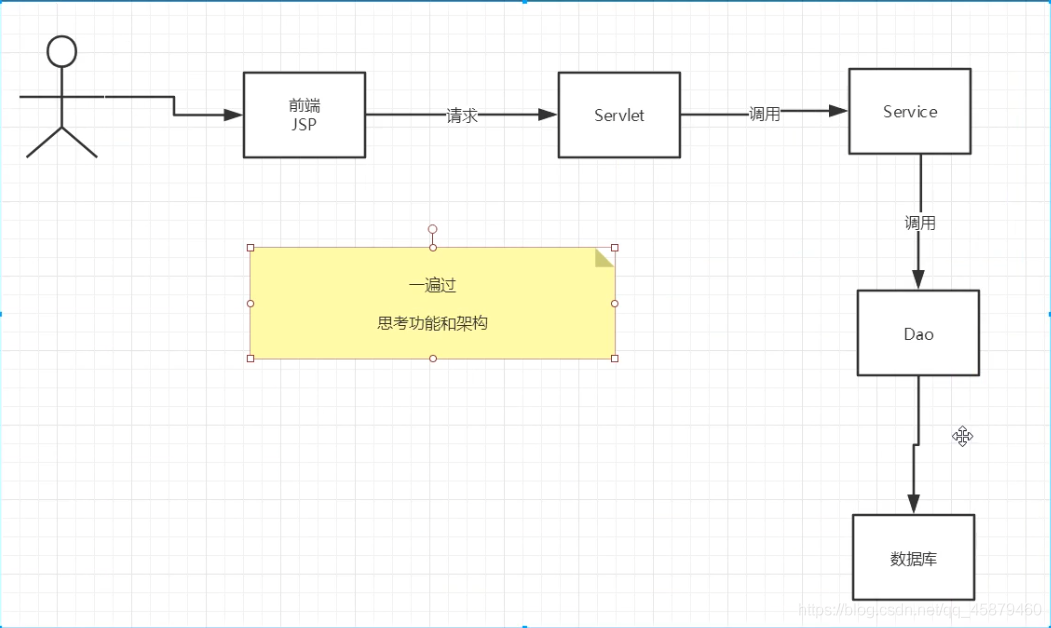Javaweb练手小项目(无框架版):smbms超市管理系统
1. 项目准备阶段
-
分析需求,模块功能分配

-
搭建一个maven web项目,配置Tomcat,测试项目能否成功跑起来
-
导入项目中会遇到的jar包,pom.xml中配置
,(jsp,servlet,mysql驱动,jstl,starand...) -
创建项目包结构

-
编写实体类--->数据库对应,ORM映射:表-类映射
-
编写基础公共类和配置文件
6.1 数据库配置文件-->db.properties
6.2 编写数据库公共类-->Basedao
-
获取数据库的连接
-
编写查询公共方法
-
编写增删改公共方法
-
释放资源
6.3 编写字符编码过滤器并注册-->CharacterEncodingFilter implements Filter
-
-
webapp下导入静态资源
2. 登录注销模块
2.1 登录功能实现
2.1.1 流程图

2.1.2 代码思路
思想:接口与实现类分离
dao层专注于数据库的操作,写SQL的地方,这地方是查询语句
编写dao层登录用户登录的接口,实现类实现,调用Basedao编写的公共方法,返回User对象
关闭资源时,connection暂时不用关,业务层关(事务)
//得到登录的用户
public User getLoginUser(Connection connection, String userCode) throws SQLException;
service层一般会有事务处理,调用dao层,关闭connection
//用户登录(账户,密码)
public User login(String userCode, String password);
Servlet:控制层,调用业务层,处理页面请求及响应(req,resp)
protected void doGet(HttpServletRequest req, HttpServletResponse resp) throws ServletException, IOException {
System.out.println("LoginServlet--start-----------");
//System.out.println(Charset.defaultCharset()); GBK
//获取用户名和密码,页面中获取req,去login.jsp中找
String userCode = req.getParameter("userCode");
String userPassword = req.getParameter("userPassword");
//和数据库中密码对比,调用业务层
UserServiceImpl userService = new UserServiceImpl();
User user = userService.login(userCode, userPassword);
//密码匹配,登录成功,将用户信息放入Session
if (user != null && user.getUserPassword().equals(userPassword)) {
req.getSession().setAttribute(Constants.USER_SESSION,user);
//跳转到主页
resp.sendRedirect("jsp/frame.jsp");
}
else {
//转发登录页面,顺带提示密码错误
req.setAttribute("error", "用户名或者密码错误");
req.getRequestDispatcher("login.jsp").forward(req,resp);
}
}
最后注册Servlet
2.2 登录功能优化(注销)
- 移除Session,注册
//移除用户session
req.getSession().removeAttribute(Constants.USER_SESSION);
resp.sendRedirect("/smbms/login.jsp"); //返回登录页面
- 编写过滤器,注册
public void doFilter(ServletRequest req, ServletResponse resp, FilterChain filterChain) throws IOException, ServletException {
HttpServletRequest request = (HttpServletRequest) req;
HttpServletResponse response = (HttpServletResponse) resp;
//过滤器,从session中获取用户
User user = (User) request.getSession().getAttribute(Constants.USER_SESSION);
if (user==null) {
response.sendRedirect("/smbms/error.jsp");
} else {
filterChain.doFilter(req,resp);
}
}
2.3 密码修改
2.3.1 思路
写项目,建议从底层向上写

2.3.2 代码编写
- dao-->写sql(update)
//修改密码
public int updatePwd(Connection connection,int id, String pwd) throws SQLException;
- service-->调用dao
//根据用户ID修改密码
public boolean updatePwd(int id, String pwd);
- servlet:从Session里面拿ID-->req.getParameter("newpassword")-->userService.updatePwd()
public void updatePwd(HttpServletRequest req,HttpServletResponse resp)
2.4 密码修改优化
验证旧密码,使用Ajax,session中有用户的密码
3. 用户管理模块

用户模块所需要的功能:UserDao接口
public interface UserDao {
//得到登录的用户
public User getLoginUser(Connection connection, String userCode) throws SQLException;
//修改密码
public int updatePwd(Connection connection,int id, String pwd) throws SQLException;
//根据用户名或者角色查询用户数
public int getUserCount(Connection connection, String userName, int userRole) throws SQLException;
//通过条件查询-userList
public List<User> getUserList(Connection connection, String userName, int userRole, int currentPageNo, int pageSize) throws SQLException;
//添加用户信息
public int addUser(Connection connection, User user) throws SQLException;
//通过userID删除对象
public int deleteUserById(Connection connection, Integer delId)throws Exception;
//修改用户名信息
public int modify(Connection connection, User user) throws SQLException;
//通过userId获取user
public User getUserById(Connection connection, String id) throws Exception;
}
3.1 获取用户数量
- daoImpl
//根据用户名或者角色查询用户数
@Override
public int getUserCount(Connection connection, String userName, int userRole) throws SQLException {
PreparedStatement pstm = null;
ResultSet rs = null;
int count = 0;
ArrayList<Object> list = new ArrayList<Object>();
if (connection != null) {
StringBuffer sql = new StringBuffer();
sql.append("select count(1) as count from smbms_user u, smbms_role r where u.userRole = r.id");
if (!StringUtils.isNullOrEmpty(userName)) {
sql.append(" and u.userName like ?");
list.add("%"+ userName + "%"); //index:0
}
if (userRole > 0) {
sql.append(" and u.userRole = ?");
list.add(userRole); //index:1
}
Object[] params = list.toArray(); //转换成数组
System.out.println("UserDaoImp->getUserCount:" + sql.toString());//调试
rs = Basedao.execute(pstm,connection,sql.toString(),params, rs);
if (rs.next()) {
count = rs.getInt("count");//从结果集中获取数量
}
//关闭资源
Basedao.closeResource(pstm, null, rs);
}
return count;
}
- serviceImpl
//查询用户总数
@Override
public int getUserCount(String userNmae, int userRole) {
Connection connection = null;
int count = 0;
try {
connection = Basedao.getConnection();
count = userDao.getUserCount(connection, userNmae, userRole);
} catch (SQLException throwables) {
throwables.printStackTrace();
} finally {
Basedao.closeResource(null, connection, null);
}
return count;
}
3.2 获取用户列表
- UserDaoImpl
//通过条件查询-userList
public List<User> getUserList(Connection connection, String userName, int userRole, int currentPageNo, int pageSize) throws SQLException {
PreparedStatement pstm = null;
ResultSet rs = null;
List<User> userList = new ArrayList<User>();
if(connection != null){
StringBuffer sql = new StringBuffer();
sql.append("select u.*,r.roleName as userRoleName from smbms_user u,smbms_role r where u.userRole = r.id");
List<Object> list = new ArrayList<Object>();
if(!StringUtils.isNullOrEmpty(userName)){
sql.append(" and u.userName like ?");
list.add("%"+userName+"%");
}
if(userRole > 0){
sql.append(" and u.userRole = ?");
list.add(userRole);
}
sql.append(" order by creationDate DESC limit ?,?");
currentPageNo = (currentPageNo-1)*pageSize;
list.add(currentPageNo);
list.add(pageSize);
Object[] params = list.toArray();
System.out.println("sql ----> " + sql.toString());
rs = Basedao.execute(pstm, connection, sql.toString(), params, rs);
while (rs.next()) {
User user = new User();
user.setId(rs.getInt("id"));
user.setUserCode(rs.getString("userCode"));
user.setUserName(rs.getString("userName"));
user.setGender(rs.getInt("gender"));
user.setBirthday(rs.getDate("birthday"));
user.setPhone(rs.getString("phone"));
user.setUserRole(rs.getInt("userRole"));
user.setUserRoleName(rs.getString("userRoleName"));
userList.add(user);
}
//关闭资源,connection暂时不用关,业务层关
Basedao.closeResource(pstm, null,rs);
}
return userList;
}
- UserServiceImpl
//根据条件查询用户列表
@Override
public List<User> getUserList(String userName, int userRole, int currentPageNo, int pageSize) {
Connection connection = null;
List<User> userList = null;
System.out.println("queryUserName ---- > " + userName);
System.out.println("queryUserRole ---- > " + userRole);
System.out.println("currentPageNo ---- > " + currentPageNo);
System.out.println("pageSize ---- > " + pageSize);
try {
connection = Basedao.getConnection();
userList = userDao.getUserList(connection, userName,userRole,currentPageNo,pageSize);
} catch (Exception e) {
// TODO Auto-generated catch block
e.printStackTrace();
}finally{
Basedao.closeResource(null, connection, null);
}
return userList;
}
3.3 获取角色操作
为了 职责统一,可以把角色的操作单独放在一个包,和pojo相对应
- RoleDaoImpl
//获取角色列表
@Override
public List<Role> getRoleList(Connection connection) throws SQLException {
ResultSet rs = null;
PreparedStatement pstm = null;
List<Role> list = new ArrayList<Role>();
if (connection != null) {
String sql = "select * from smbms_role";
pstm = connection.prepareStatement(sql);
Object[] params = {};
rs = Basedao.execute(pstm, connection, sql, params, rs);
while (rs.next()) {
Role role = new Role();
role.setId(rs.getInt("id"));
role.setRoleCode(rs.getString("roleCode"));
role.setRoleName(rs.getString("roleName"));
list.add(role);
}
Basedao.closeResource(pstm, null, rs);
}
return list;
}
- RoleServiceImpl
public class RoleServiceImpl implements RoleService{
//业务层都会调用dao层,引入dao层;无参构造直接调用
private RoleDao roleDao;
public RoleServiceImpl() {
roleDao = new RoleDaoImpl();
}
//获得角色列表
@Override
public List<Role> getRoleList() {
Connection connection = null;
List<Role> roleList = null;
try {
connection = Basedao.getConnection();
roleList = roleDao.getRoleList(connection);
} catch (SQLException throwables) {
throwables.printStackTrace();
} finally {
Basedao.closeResource(null, connection, null);
}
return roleList;
}
}
3.4 用户显示的Servlet(重点+难点)
-
获取用户前端的数据
-
判断请求是否需要执行,看参数的值判断
-
为了实现分页,需要就算出当前页面和分页面,页面大小
-
用户列表展示
-
返回前端
//通过条件查询-userList(重点+难点)
public void query(HttpServletRequest req, HttpServletResponse resp) throws IOException {
//查询用户列表
//从前端获取数据
String queryUserName = req.getParameter("queryname");//用户姓名
String temp = req.getParameter("queryUserRole"); //用户role
String pageIndex = req.getParameter("pageIndex"); //页标
int queryUserRole = 0; //默认用户role为0
//获取用户列表
UserServiceImpl userService = new UserServiceImpl();
RoleServiceImpl roleService = new RoleServiceImpl();
List<User> userList = null;
List<Role> roleList = null;
//第一次走这个请求,一定是第一页,页面大小固定
int pageSize = Constants.PAGE_SIZE; //可以写到配置文件中,方便修改
int currentPageNo = 1;
//三个if,判断前段请求的参数
if (queryUserName == null){
queryUserName = "";
}
if (temp != null && !temp.equals("")) {
queryUserRole = Integer.parseInt(temp);//给查询赋值 0,1,2
}
if (pageIndex != null) {
try {
currentPageNo = Integer.parseInt(pageIndex);
} catch (NumberFormatException e) {
resp.sendRedirect("error.jsp");
}
}
//获取用户总数
int totalCount = userService.getUserCount(queryUserName, queryUserRole);
//总页数支持,设置参数
PageSupport pageSupport = new PageSupport();
pageSupport.setCurrentPageNo(currentPageNo);
pageSupport.setPageSize(pageSize);
pageSupport.setTotalCount(totalCount);
//控制首页尾页
int totalPageCount = pageSupport.getTotalPageCount();
if (currentPageNo < 1) {
currentPageNo = 1;
} else if (currentPageNo > totalPageCount) {
currentPageNo = totalPageCount;
}
//用户列表展示
userList = userService.getUserList(queryUserName, queryUserRole, currentPageNo, pageSize);
req.setAttribute("userList",userList);
//角色列表
roleList = roleService.getRoleList();
req.setAttribute("roleList", roleList); //用户列表
req.setAttribute("totalCount", totalCount); //用户总数总数
req.setAttribute("currentPageNo", currentPageNo); //当前页
req.setAttribute("totalPageCount",totalPageCount); //页面总数
req.setAttribute("queryUserName",queryUserName);
req.setAttribute("queryUserRole",queryUserRole);
//返回前端
try {
req.getRequestDispatcher("userlist.jsp").forward(req, resp);
} catch (ServletException e) {
e.printStackTrace();
} catch (IOException e) {
e.printStackTrace();
}
}
3.5 添加用户
- UserDaoImpl
//添加用户信息
@Override
public int addUser(Connection connection, User user) throws SQLException {
PreparedStatement pstm = null;
int updateRows = 0;
if (connection != null) {
String sql = "insert into smbms_user (userCode,userName,userPassword,userRole,gender,birthday,phone,address,creationDate,createdBy) values(?,?,?,?,?,?,?,?,?,?)";
Object[] params = {user.getUserCode(), user.getUserName(), user.getUserPassword(), user.getUserRole(), user.getGender(), user.getBirthday(), user.getPhone(), user.getAddress(), user.getCreationDate(), user.getCreatedBy()};
updateRows = Basedao.update(pstm,connection,sql,params);
Basedao.closeResource(pstm, null,null);
}
return updateRows;
}
- UserServiceImpl(事务处理)
//添加用户信息
@Override
public boolean addUser(User user) {
Connection connection = null;
boolean flag = false;
int updateRows = 0;
try {
connection = Basedao.getConnection();
connection.setAutoCommit(false); //开启事务
updateRows = userDao.addUser(connection, user);
connection.commit();
if (updateRows > 0) {
flag = true;
System.out.println("添加成功");
} else {
System.out.println("添加失败");
}
} catch (SQLException throwables) {
throwables.printStackTrace();
try {
connection.rollback();//添加失败,数据回滚
} catch (SQLException e) {
e.printStackTrace();
} finally{
Basedao.closeResource(null, connection, null);
}
}
return flag;
}
- UserServlet
//添加用户信息
public void addUser(HttpServletRequest req, HttpServletResponse resp) throws IOException, ServletException {
UserService userService = null;
User user = null;
//获取前端信息
String userCode = req.getParameter("userCode");
String userName = req.getParameter("userName");
String userPassword = req.getParameter("userPassword");
//String ruserPassword = req.getParameter("ruserPassword");
String gender = req.getParameter("gender");
String birthday = req.getParameter("birthday");
String phone = req.getParameter("phone");
String address = req.getParameter("address");
String userRole = req.getParameter("userRole");
//给用户赋值
user = new User();
user.setUserCode(userCode);
user.setUserName(userName);
user.setUserPassword(userPassword);
user.setAddress(address);
try {
user.setBirthday(new SimpleDateFormat("yyyy-MM-dd").parse(birthday));
} catch (ParseException e) {
e.printStackTrace();
}
user.setGender(Integer.valueOf(gender));
user.setPhone(phone);
user.setUserRole(Integer.valueOf(userRole));
user.setCreationDate(new Date());
user.setCreatedBy(((User) req.getSession().getAttribute(Constants.USER_SESSION)).getId());
userService = new UserServiceImpl();
if (userService.addUser(user)) { //添加用户成功
resp.sendRedirect(req.getContextPath() + "/jsp/user.do?method=query");
} else {
req.getRequestDispatcher("useradd.jsp").forward(req, resp);
}
}
3.6 删除用户
- UserDaoImpl
//通过用户id删除用户
public int deleteUserById(Connection connection, Integer delId) throws SQLException {
PreparedStatement pstm = null;
int updateRows = 0;
if (connection != null) {
String sql = "delete from smbms_user where id=?";
Object[] params = {delId};
updateRows = Basedao.update(pstm,connection,sql,params);
Basedao.closeResource(pstm, null,null);
}
return updateRows;
}
- UserServiceImpl
//通过id删除用户
public boolean deleteUserById(Integer delId) throws Exception {
Connection connection = null;
boolean flag = false;
int updateRows = 0;
try {
connection = Basedao.getConnection();
connection.setAutoCommit(false); //开启事务
updateRows = userDao.deleteUserById(connection, delId);
connection.commit();
if (updateRows > 0) {
flag = true;
} else {
System.out.println("删除失败");
}
} catch (SQLException throwables) {
throwables.printStackTrace();
try {
connection.rollback();//添加失败,数据回滚
} catch (SQLException e) {
e.printStackTrace();
} finally{
Basedao.closeResource(null, connection, null);
}
}
return flag;
}
- UserServlet
//删除用户
private void delUser(HttpServletRequest request, HttpServletResponse response) throws Exception {
String id = request.getParameter("uid");
Integer delId = 0;
try {
delId = Integer.parseInt(id);
} catch (Exception e) {
delId = 0;
}
HashMap<String, String> resultMap = new HashMap<String, String>();
if (delId <= 0) {
resultMap.put("delResult", "notexist");
} else {
UserService userService = new UserServiceImpl();
if (userService.deleteUserById(delId)) {
resultMap.put("delResult", "true");
} else {
resultMap.put("delResult", "false");
}
}
}
3.7 修改用户
- UserDaoImpl
//修改用户信息
public int modify(Connection connection, User user) throws SQLException {
int updateRows = 0;
PreparedStatement pstm = null;
if (connection != null) {
String sql = "update smbms_user set userName=?,gender=?,birthday=?,phone=?,address=?,userRole=?,modifyBy=?,modifyDate=? where id =?";
Object[] params = {user.getUserName(), user.getGender(), user.getBirthday(),
user.getPhone(), user.getAddress(), user.getUserRole(), user.getModifyBy(),
user.getModifyDate(), user.getId()};
updateRows = Basedao.update(pstm,connection,sql,params);
Basedao.closeResource(pstm, null,null);
}
return updateRows;
}
- UserServiceImpl
//修改用户
@Override
public boolean modify(User user) {
// TODO Auto-generated method stub
Connection connection = null;
boolean flag = false;
try {
connection = Basedao.getConnection();
if (userDao.modify(connection, user) > 0)
flag = true;
} catch (Exception e) {
// TODO Auto-generated catch block
e.printStackTrace();
} finally {
Basedao.closeResource(null, connection, null);
}
return flag;
}
- UserServlet
//修改用户数据
private void modify(HttpServletRequest request, HttpServletResponse response)
throws Exception {
String id = request.getParameter("uid");
String userName = request.getParameter("userName");
String gender = request.getParameter("gender");
String birthday = request.getParameter("birthday");
String phone = request.getParameter("phone");
String address = request.getParameter("address");
String userRole = request.getParameter("userRole");
User user = new User();
user.setId(Integer.valueOf(id));
user.setUserName(userName);
user.setGender(Integer.valueOf(gender));
try {
user.setBirthday(new SimpleDateFormat("yyyy-MM-dd").parse(birthday));
} catch (ParseException e) {
// TODO Auto-generated catch block
e.printStackTrace();
}
user.setPhone(phone);
user.setAddress(address);
user.setUserRole(Integer.valueOf(userRole));
user.setModifyBy(((User) request.getSession().getAttribute(Constants.USER_SESSION)).getId());
user.setModifyDate(new Date());
UserService userService = new UserServiceImpl();
if (userService.modify(user)) {
response.sendRedirect(request.getContextPath() + "/jsp/user.do?method=query");
} else {
request.getRequestDispatcher("usermodify.jsp").forward(request, response);
}
}
3.8 实现Userdao的其他接口
4. 供应商管理模块
-
检索功能:条件查询+详细信息
-
添加功能
-
修改功能
-
删除功能

